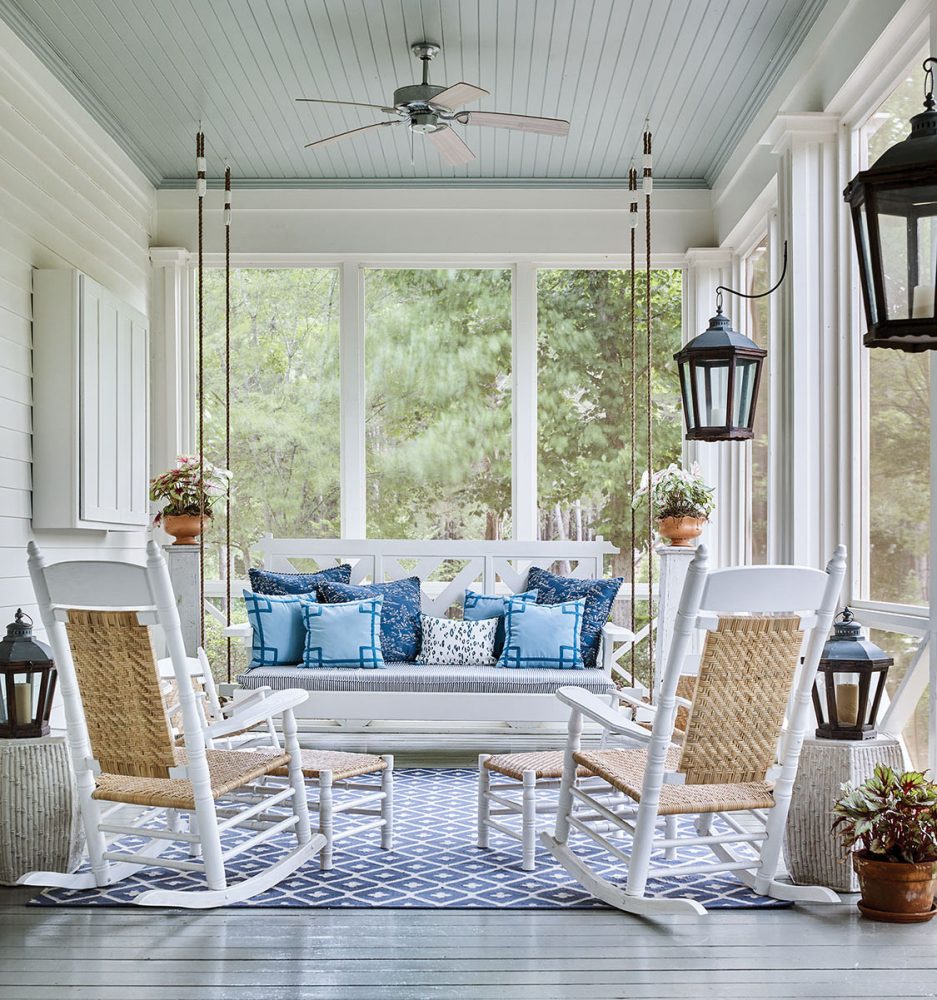When looking to buy a sofa, the choices can seem overwhelming. We asked four designers to help make sense of the process. Here’s their advice.
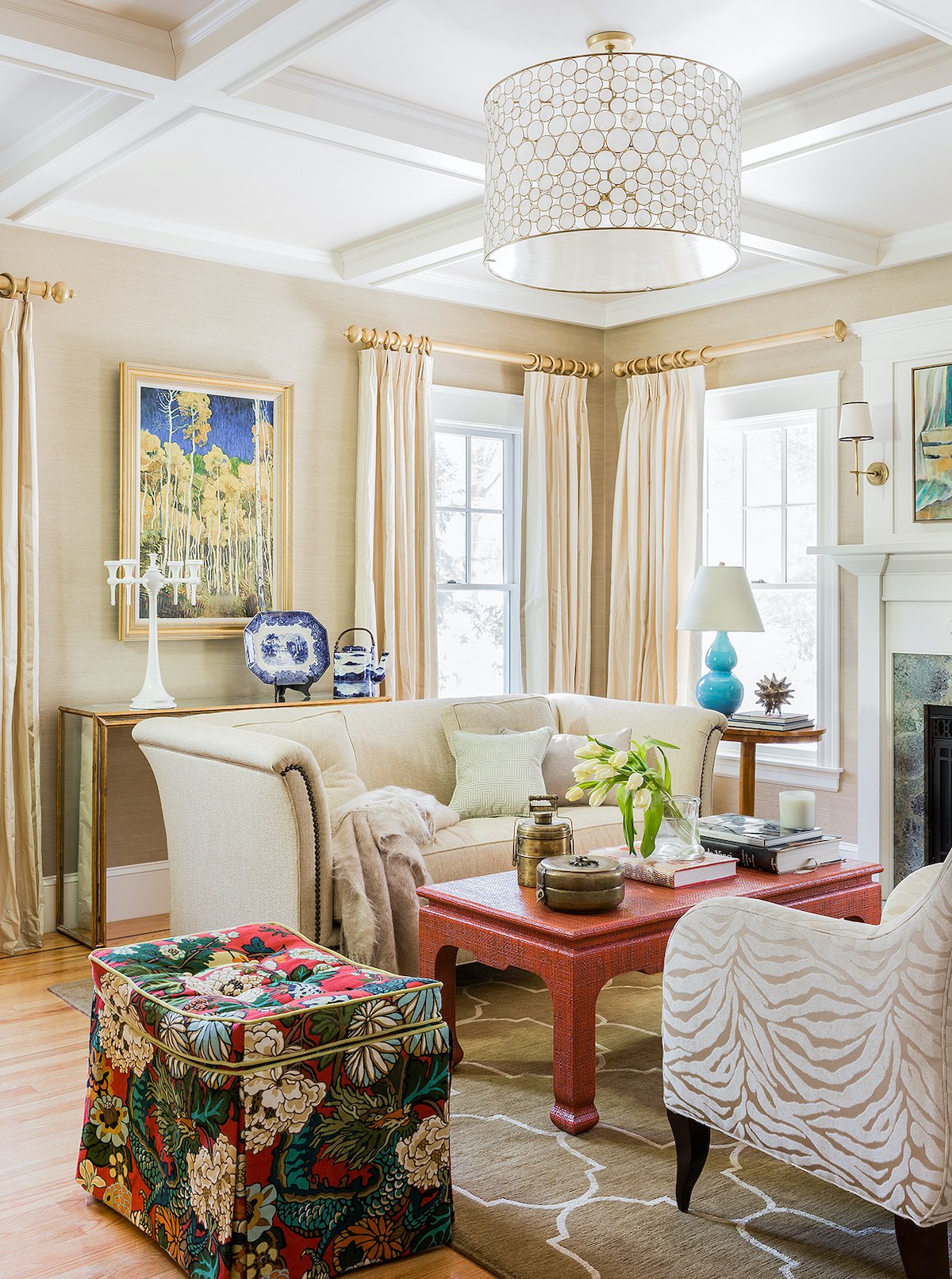
Photo by Michael J. Lee
Robin Gannon designed the shelter-arm sofa to help make the space in front of the fireplace feel a bit more intimate in size. “This is more of a couple’s area so it creates a great “after dinner drinks” atmosphere in front of the fire.” Injections of color come from the ottoman, coffee table and table lamp.
Budget + Quality
“Before we start choosing a sofa, we like to get our arms around the client’s budget because a quality sofa is a big investment,” says Anne Hulcher Tollett of Hanover Avenue in Richmond, Virginia. “Once the budget is in place, I know what altitude I am flying in and what brands to choose from within that range.” According to Jacksonville, Florida-based Phoebe Howard of Mr. & Mrs. Howard, “Spending money on the inner workings of a sofa (8-way hand-tied with a quality frame) is well worth it. A less expensive sofa has a shelf life of seven years, while a higher quality one is close to 30 years. Plus, if you re-cover it over and over again and repurpose the cushions, it might outlive you!” Robin Gannon of Robin Gannon Interior Design in Lexington, Massachusetts, adds, “There can be some resistance at first because clients don’t understand why a high-quality sofa can be pricey, but I always tell them to put their money where their bum is! It is the one thing that will not disappoint. You can always find cost-effective side tables and cocktail tables, but do not skimp on the sofa. Good quality stands test of time.”
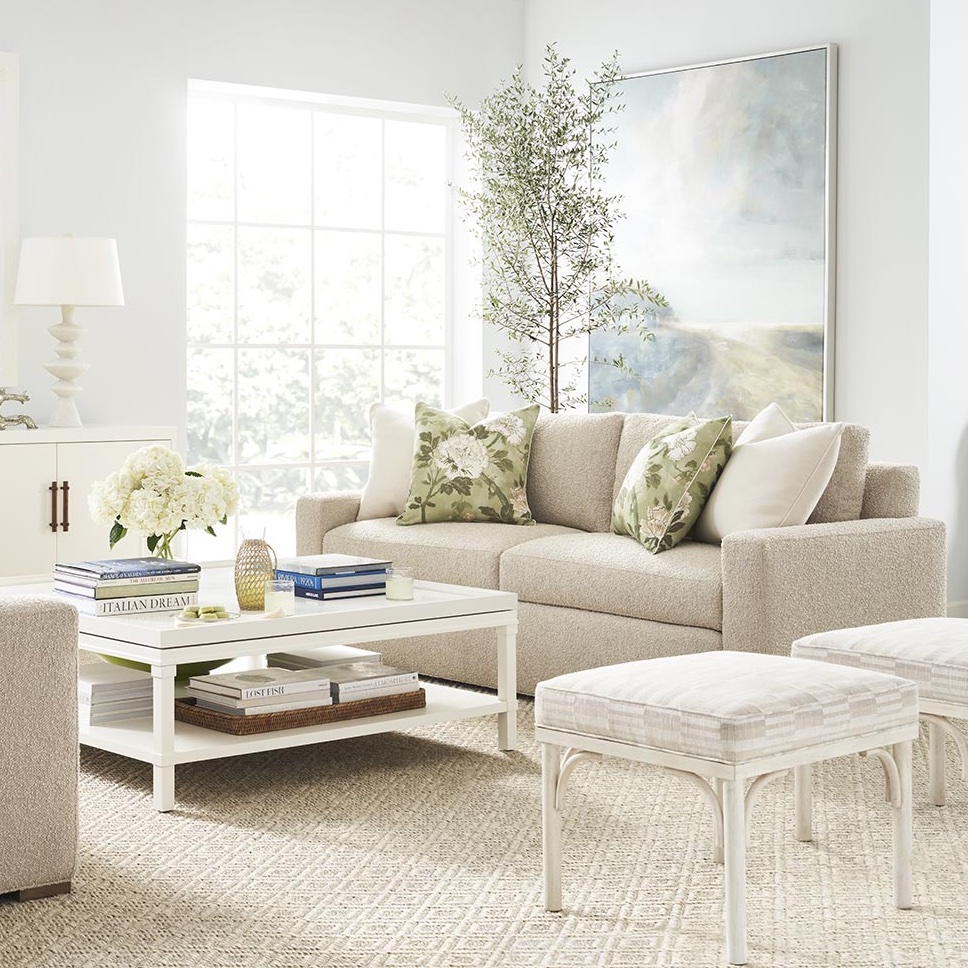
Looking for style without breaking the bank? Opt for a company with easy 8-way hand-tied custom programs like Sherrill Furniture. Crafted with expertise and attention to detail, their custom programs ensure durability and comfort while allowing you to tailor your sofa to your unique style preferences. With Sherrill’s rich history of quality craftsmanship, you can trust you’re getting both value and sophistication. Why compromise? Choose a sofa that hits your budget and reflects your personality. Happy lounging!
Sponsored by Sherrill Furniture
Measuring and Creating a Floor Plan
All the designers we spoke to stressed the importance of accurate measuring and determining what other pieces will be in the room before you even begin to think about the style of a sofa. “I recommend you draw your room size and draw your furniture arrangement,” says Howard. “Floor plans don’t lie, and once you have your size determined, you can look at options.” And while it may seem intuitive, Sara Hillery of Sara Hillery Interior design in Richmond notes that “you have to be sure that there is adequate space to navigate around the pieces chosen for the floor plan. You don’t want people to have challenges—too narrow a space for example—to reach the sofa or anything else in the room.” Adds Gannon, “We consider not only the floor plan but also the room elevations. For instance, it’s important to know if I’m putting the sofa against a window. In that case, I need to know where the windowsill falls so the back of the sofa is appropriately sized.”
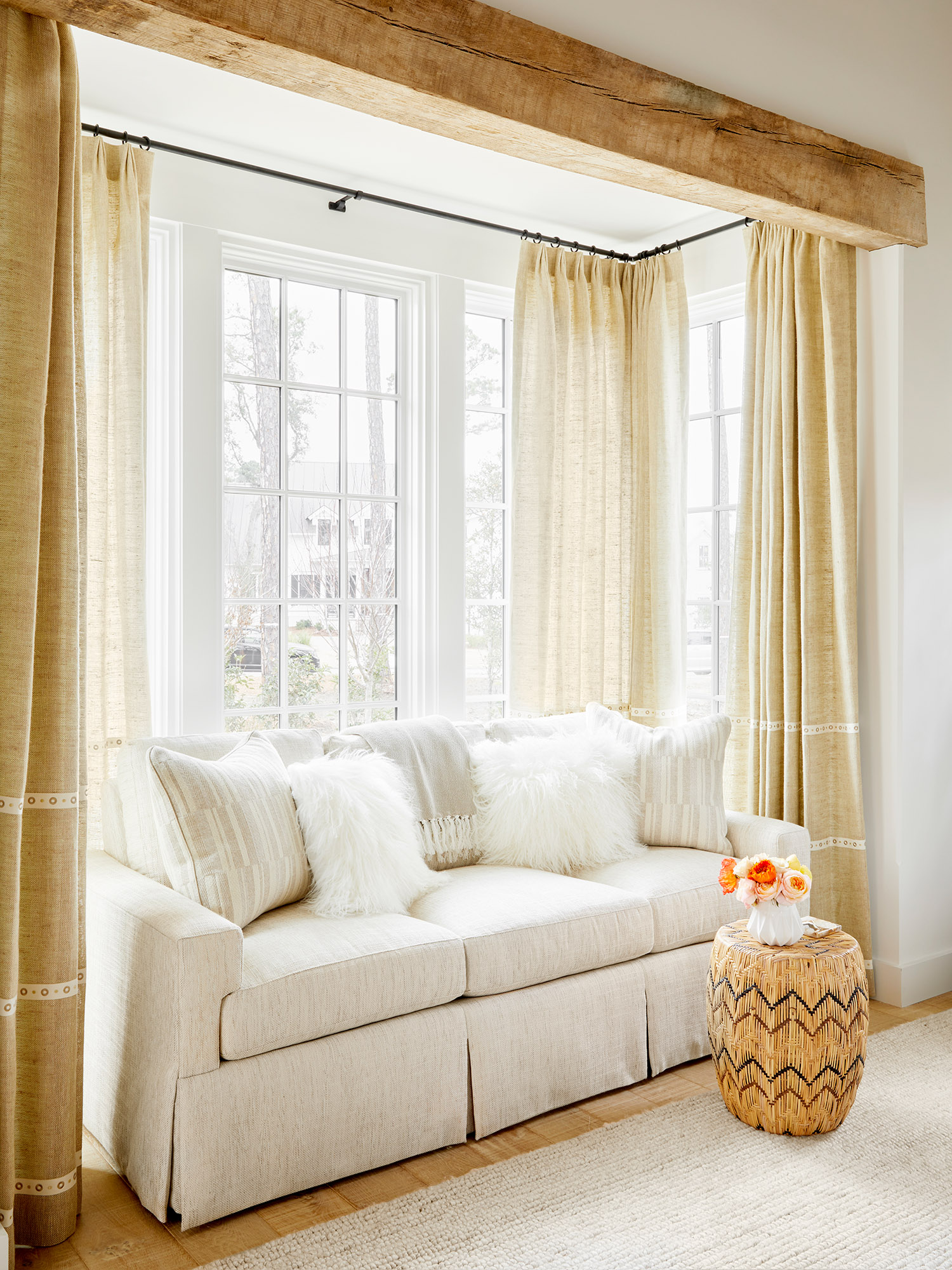
Photo by Adam Kuehl
Phoebe Howard of Mr. & Mrs. Howard chose the Snug sofa from Sherrill Furniture with three pillows and a tailored pleated skirt for the primary bedroom's bay window in Flower’s Palmetto Bluff showhouse.
CHOOSING YOUR SOFA
Home and Personal Style
While designers consider the architectural style of your home, most agree that your personal style should be the deciding factor. “We work on a lot of historic homes,” says Gannon. “While we are meticulous when it comes to preserving the original architectural details on the exterior and interior such as molding and trims, we are not so concerned about the style of the furnishings relating to the architecture. For example, a traditional house can handle a more transitional, cleaner look on the inside. And since a modern style can feel a little austere on the exterior, you may want the interiors to be cozier. While you don’t want to totally ignore the vernacular of the house, you can have the interiors reflect your personal preferences.”

Photo by Michael J. Lee
Gannon included a more modern nod to a chesterfield sofa from Hickory Chair in a cream linen that made sense in this visually engaging room. “We kept the fabric light because there is a lot going on in this room so we didn’t want to call too much attention to the sofa so your eye stopped there and didn’t move around the room to take in the rest.”
Adds Tollett, “We are always focused on understanding our client’s style preferences, but I do believe a blend of modern and antiquity is so chic. I’ve seen houses that are extremely modern have a beautiful French antique settee and it looks so charming. Similarly, a modern piece can serve as a foil. For example, a Minotti sofa in a classic row house—now that can look hot!”
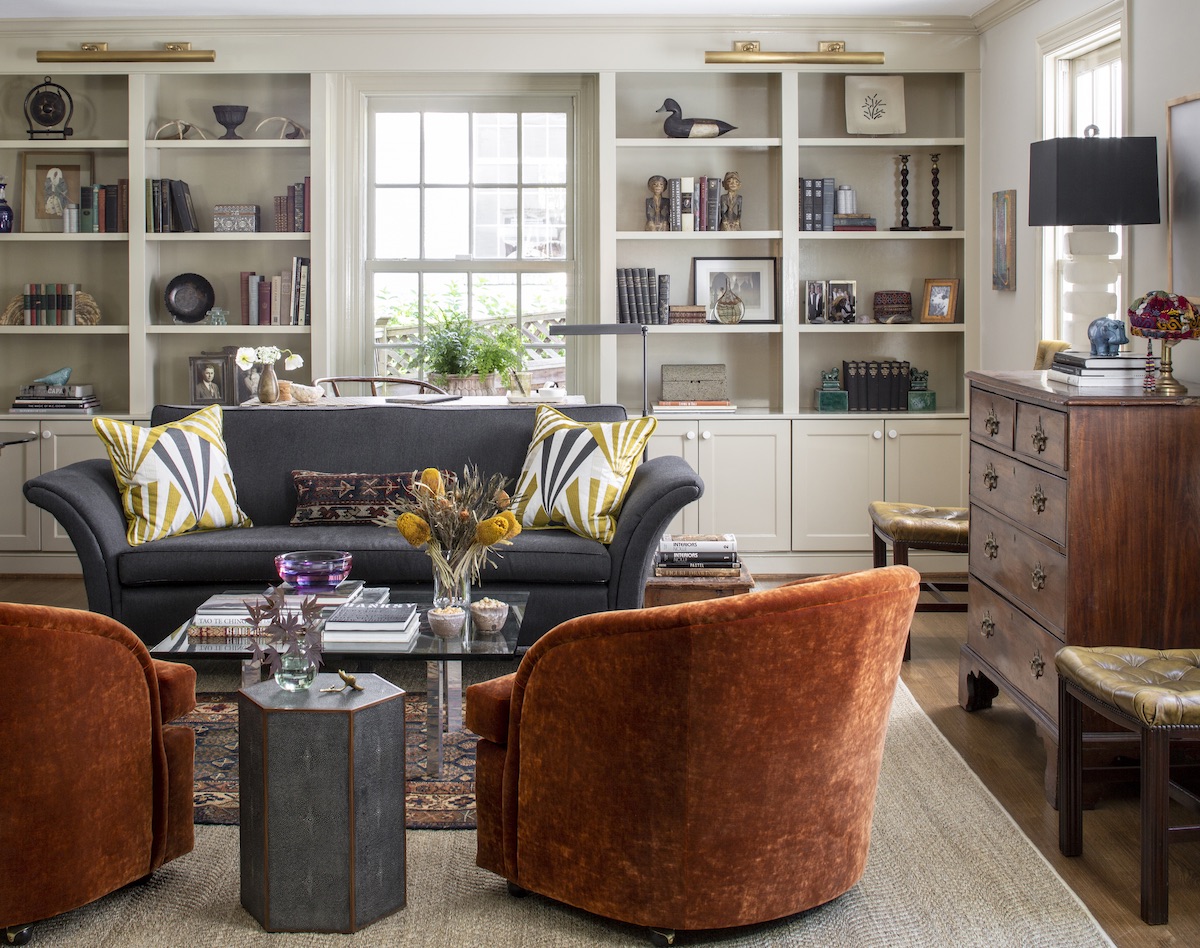
Photo by Helen Norman, courtesy of Hanover Avenue
Tollett updated an antique sofa with lively geometric print pillows and paired them with two swivel chairs, reflecting styles both old and new. “We are always focused on understanding our client’s style preferences, but I do believe a blend of modernity and antiquity is so chic,” says Tollett.
If clients are new to the process and simply can’t settle on a look, designers often steer them towards more classic silhouettes that have proven to last. While trends in furniture are less dramatic than fashion, manufacturers do entice consumers to try new things such as track arms, block legs, or skirts, explains Gannon. “I often steer my clients towards a silhouette that has stood the test of time in a neutral fabric—the best they can afford in a style that can slip in anywhere. You can always swap out pillows and throws or even slip-cover a sofa,” she says. Adds Tollett, “I direct them away from any style that has too many bells and whistles. A sofa with classic lines and an English or track arm (big rolled arms don’t stand the test of time) in a performance wool or linen has staying power—kind of like a good Armani suit or the perfect little black dress that you dress up or dress down for many years to come.”
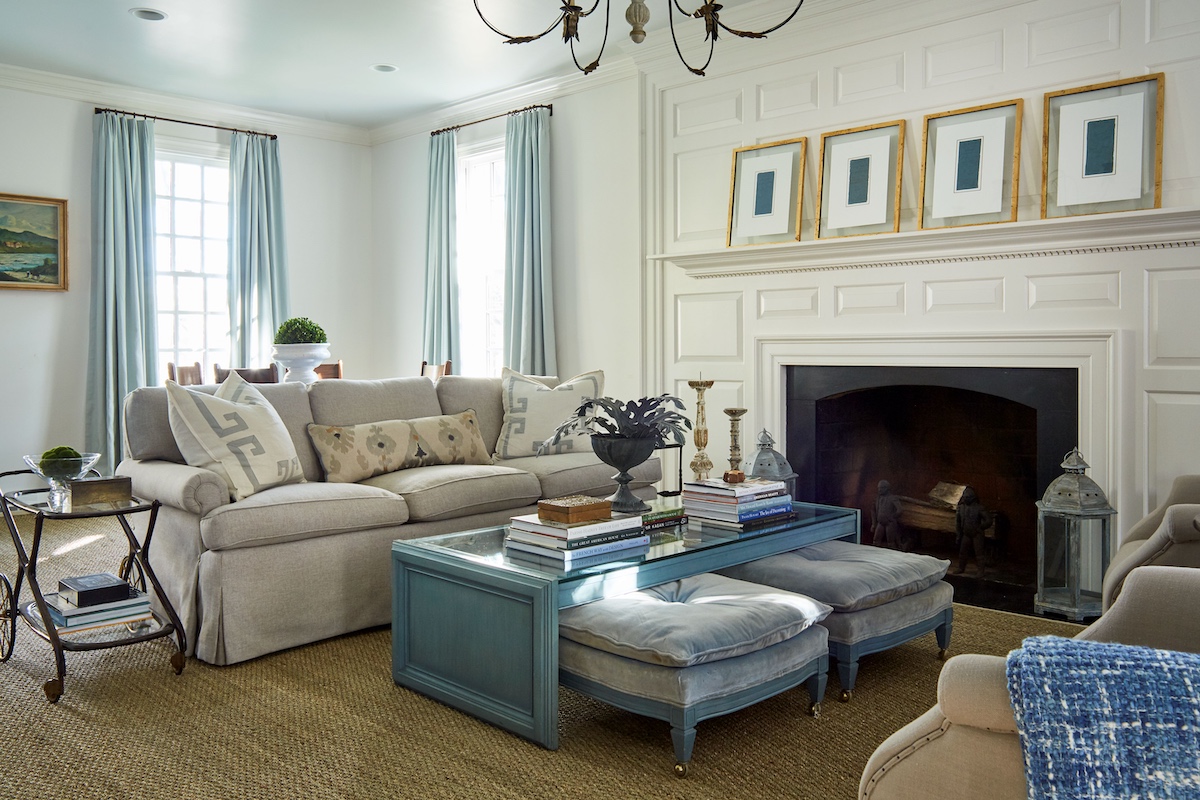
Photo by Kip Dawkins
An oatmeal linen sofa anchors a lively living room for a busy young family designed by Sara Hillery. A pair of wing chairs, custom coffee table with nesting ottomans, and a vintage Italian tea cart give these homeowners the flexibility to rearrange this space based on their varying entertaining needs.
Ceiling Height
Ceiling heights also need to be taken into account when choosing a sofa. As Hillery explains, “Tall ceilings need a sofa with a taller back if there is not something else in the room that is going to help compensate for that height. If you have a mid-century home with lower ceilings, embracing a low-to-the-ground sofa may feel more appropriate.”

Photo by Michael Hunter Photography
Hillery employed a contemporary sectional in a mid-century modern house to serve as the focal point for a bright and airy living room in Houston. Custom-painted hexagonal bunching tables, a bright piece of art, and accent pillows add colorful details to a space grounded by monochromatic blues.
How the Sofa Will Be Used
Where the sofa is located—living room, den, or at the foot of a bed—will directly affect your choice. In conjunction with that is considering how the room will be used the majority of the time. “The biggest factor with any sofa is comfort, but comfort comes in varying forms depending on the use” says Howard. “If you are intending to lie down and watch television or lounge in a family room, there are different considerations than if you are entertaining guests in a living room. In the former, you are going to want more seat depth and have an arm that is high enough to provide head support. In the latter, you want a shallower depth for more upright sitting that allows for conversation and visiting with friends.” Gannon notes, “If it’s in an entertaining space, you don’t want the sofa to be so deep that guests have a challenge getting out of it with grace. Also, if you need a sofa that can cram as many people in, then you may need a thinner arm for more seating space. We spend a lot of time talking with clients about how that sofa is going to be used.”
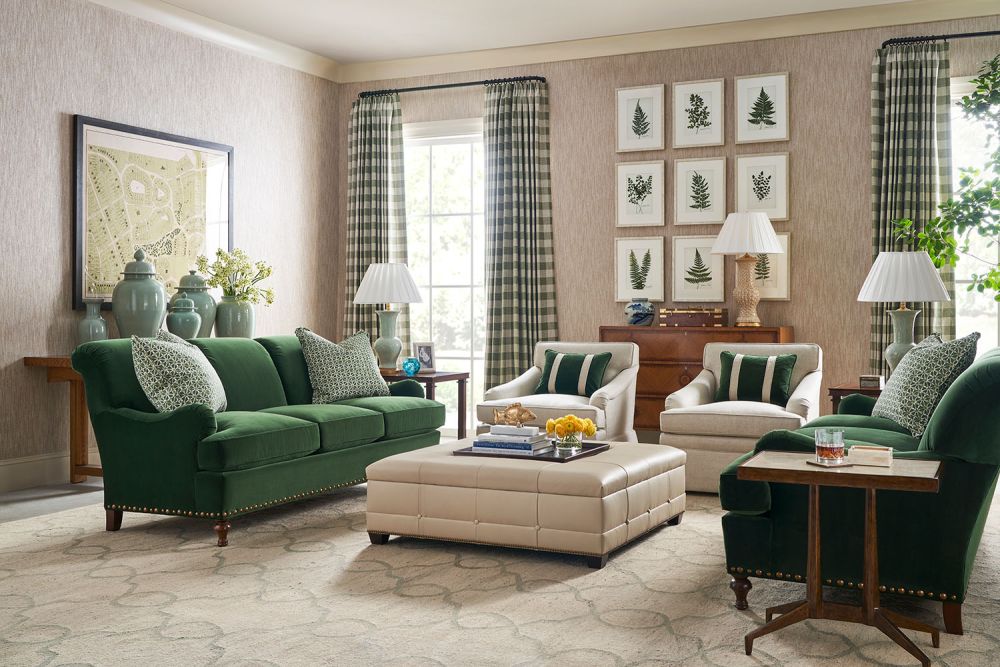
Photo courtesy of Sherrill Furniture
Howard included a Bridgewater Sofa with rolled arms, wooden legs with nailhead trim on the bottom from her collection for Sherrill furniture in this well-balanced room. Howard always advises honesty when choosing a sofa; “If you if have messy family members or pets, go with a practical choice. Don’t set yourself up for failure.”
Tollett says, “We also consider the size of people using the sofa. If the husband is really tall or the wife is very small, the depth of the sofa becomes key; you need to find a size that both are comfortable sitting on. Also, if the family will be watching television, consider if the TV is a little bit higher up, say over a mantel. If so, then the back needs to be tall enough to allow them to lean back for viewing.”
When it comes to the arms, there are many options. Again, the choice depends on the sofa’s primary purpose. “If you are lounging and have a drink next to you, don’t get a shelter arm that is too high up,” says Howard. “Instead, choose a low-track arm or a low-rolled arm,” says Howard. “I prefer to have the sofa arm fit the body ergonomically so that it nestles the arm well.” Adds Gannon, “In a living room, sometimes we select a really wide arm so you can perch on it and have a conversation. You also want to look at what’s happening on either side of the sofa; you don’t want a tall arm that you have trouble seeing over for conversation. However, if you have a sofa staring straight ahead at a beautiful view, a tuxedo or shelter arm sofa can impart a lovely feel.” Hillery prefers a soft, padded arm, and an English arm is one of her go-to choices.
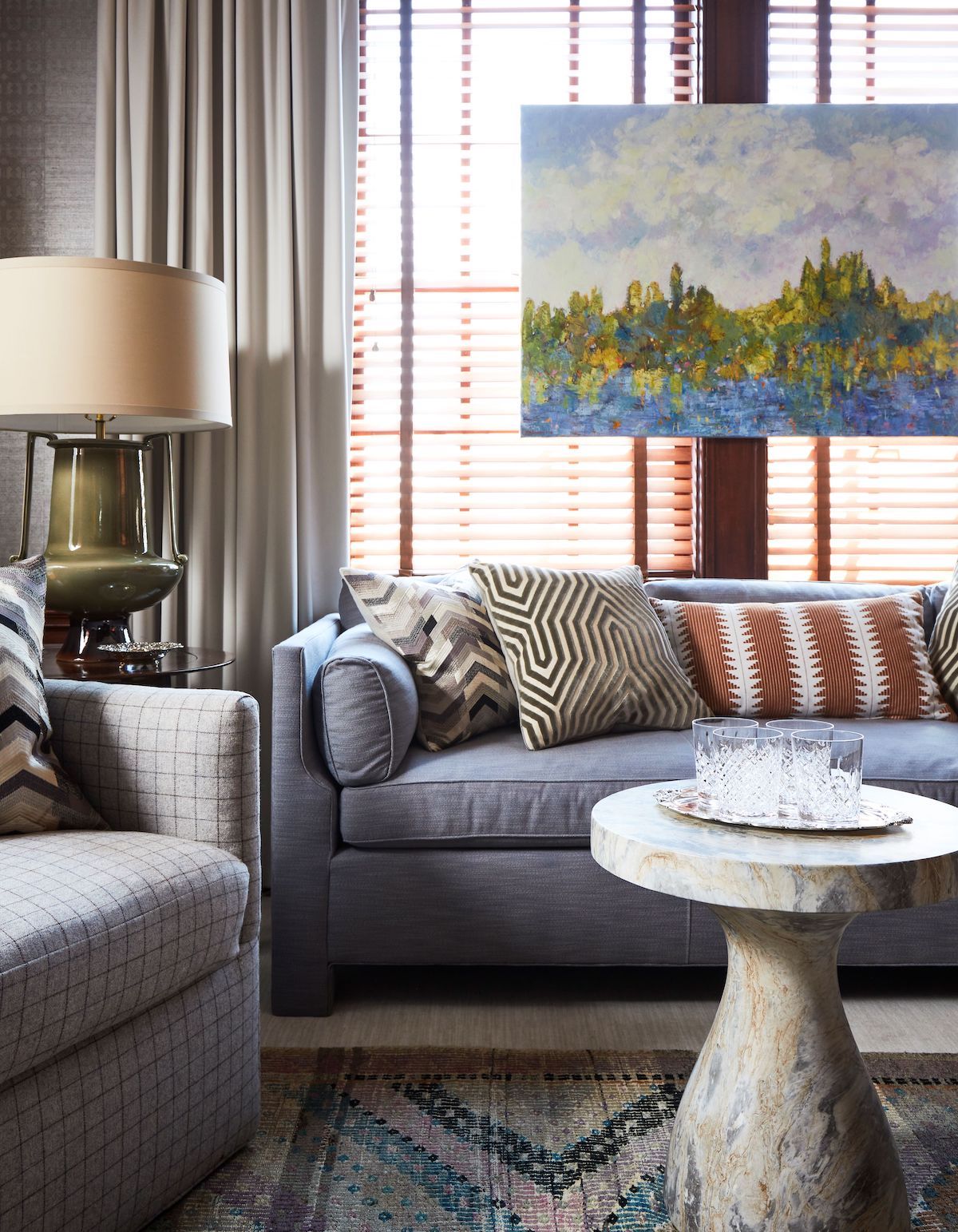
Photo by Kip Dawkins
Hillery chose an edited mix of old and new textures and styles for this study in a historic high-rise in Washington, DC. A contemporary blue sofa cozies up to a traditional plaid swivel chair while a marble coffee table exudes both modern and classic sophistication. Colorful accents come in through the art, rug, and geometric pillows.
How the Sofa Presents in the Room
Not only is it important to think about what room your sofa will be in, but you also need to consider where it will reside in the room. Is it against a wall, floating in the room, or placed at an angle? “If you are seeing the back of the sofa, you want the profile to be engaging—a cute, sexy back,” says Tollett. Adds Gannon, “You also need to consider how people will approach the sofa. For example, If you are walking into the side of a sofa, you don’t want a high tuxedo arm which may say ‘back off’ or feel uninviting; a lower rolled arm has a friendlier, more come hither feeling to it.”

Photo by Michael J. Lee
Gannon designed the daybed to float in between two seating areas for cozy tete-a-tetes in a chenille fabric. “We placed a rolled arm leather sofa in the background because the clients are from Ireland and we wanted to give a little bit of an 'old world' atmosphere to some of the design and leather is a great way to do that.”
Tollett has this additional advice: “People can get really hung up on the height of the table next to the sofa, but I don’t worry about that. I’ve used 30-inch-high tables where you have to lift your arm a bit to set a drink down as well as 18-inch garden stools next to a sofa to plop a drink on. It doesn’t have to have a perfect relationship. It’s all about balancing the scale and proportion of the arm shape and the shape of the table next to it.”
Cushions: Filling
“I love an all-down sofa, but it needs a lot of maintenance, so I usually recommend a spring-coiled foam insert with a down envelope to get the softness of down and the firmness you want,” says Gannon. “It’s great quality and lasts a long time. For the back pillows, we usually do a foam core and down wrap—it’s soft enough to sink into but not so soft that you can’t rise up easily.”
“A less expensive sofa has a shelf life of seven years, while a higher quality one is close to 30 years—you can re-cover it over and over again and repurpose the cushions and it might outlive you!”
—Phoebe Howard
Howard advises not setting yourself up for failure when it comes to the selection. “Down is wonderful and very luxurious to sit in, but the cushions require daily fluffing. if you are not going to do that, then go with a more maintenance-free option.” Hillery notes that once you make a choice, there are degrees of firmness depending on the client’s preferences, especially with brands in High Point where everything is customizable. “I look at the end user—the person who will be sitting on it on a daily basis and their preferences. For one couple, I did a two-pillow cushion with one in a medium density and one in a firm density.”
Number of Sofa Cushions
“No matter how many cushions you choose, the sofa needs to be a minimum of 84 inches if you want three people to sit on it,” says Tollett. “In a family with children, I usually recommend a single bench cushion; that way no one is sitting on a crack— children like to complain about that. But you only want to go with a bench cushion when purchasing a well-made product. Otherwise, when someone sits solo in the middle the cushion it can turn into a smile!”
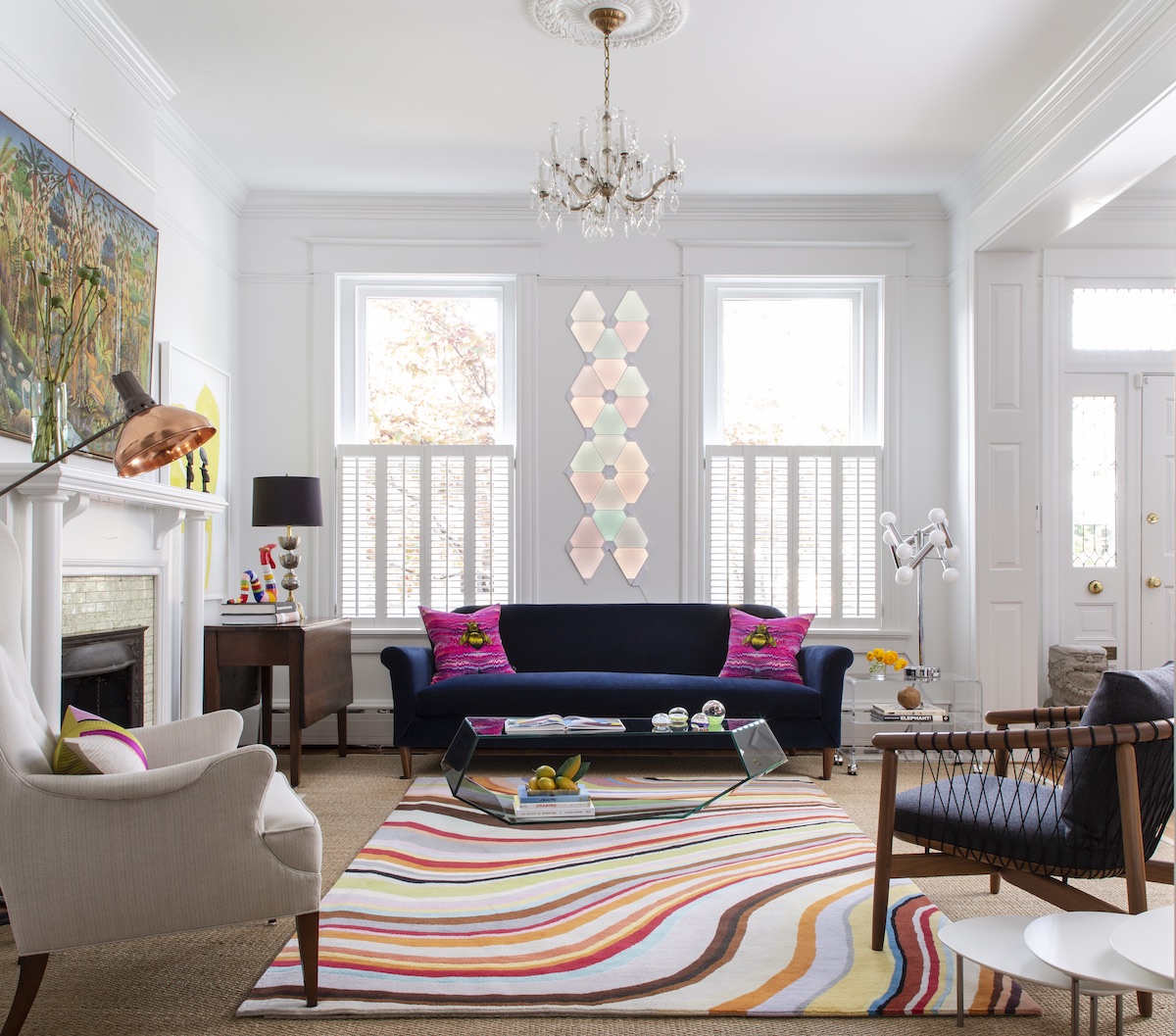
Photo by Helen Norman, courtesy of Hanover Avenue
Tollett created a mash up of interesting pieces and colors to shake up a historic home. The custom blue sofa with a bench seat serves as a grounding element in the room.
“Even with a high-quality sofa, a bench cushion may pop up a bit on the outer corners and can get sunken in different spots, so you need to be diligent about flipping the cushion and fluffing it,” says Howard. Adds Hillery, “The fabric on a bench cushion can tend to roll, so I always have a conversation with my clients about that. If you opt for tufting, that detail can better hold the fabric to the cushion.”
“The number of cushions is really a style preference and depends on the other upholstered pieces in the room,” says Howard. “Many people want three cushions because they are hoping three guests will sit on the sofa. I find that rarely happens if there is other adequate seating in the room. At a large gathering, guests may need to use all the space available, so I would go with three over two. All three configurations have merit depending on the design choices in the room.”
Sectional Vs. Two Sofas
“Sectionals have lost their stigma from 20 years ago,” says Howard. “There are many young families that want the scale of a sectional so the whole family can pile onto it to watch television in a den or dedicated media room. They are comfortable, offering that extra corner or two, and totally customizable for any space.” Tollett says she is not a huge fan of sectionals if two sofas would work. “Of course, if a client really wants one, we will create a beautiful bespoke-looking sectional, making sure to keep any bulbous look in check.” Gannon believes in two sofas for a very practical reason. “If you move, then you may not have a place for a big hulking sectional, whereas two sofas can be separated. One may end up in an office or den. Or if it is between 84 to 96 inches, it could be at the end of a bed in a larger bedroom. You just have more options.”
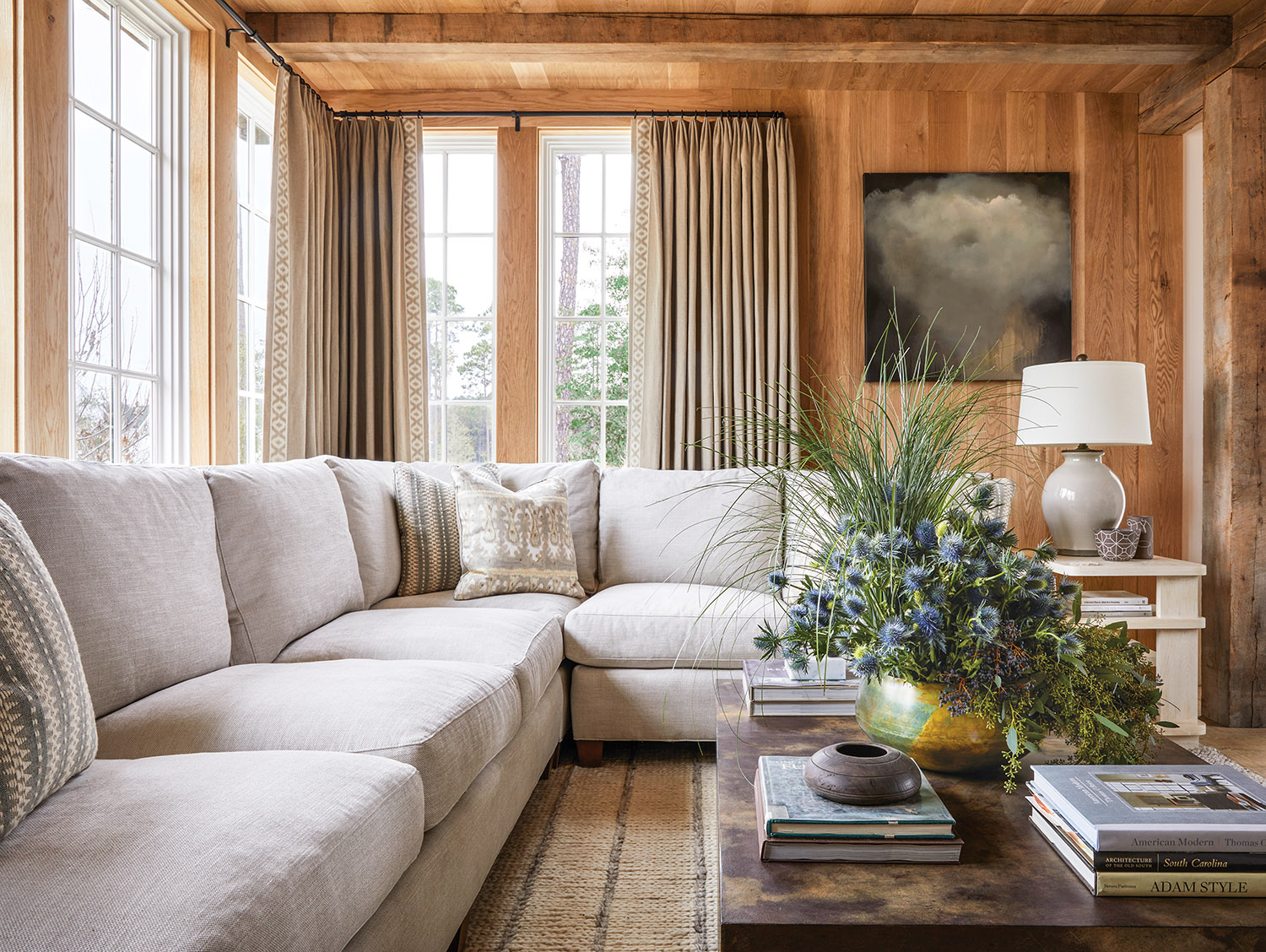
Photo by Adam Kuehl
For a cozy paneled den, Howard included a capacious linen sectional with multiple cushions. “No one likes to sit on a crack or seam, but I use many configurations of pillows; it really depends of how the room will be used and by how many people on a daily basis,” says Howard.
CHOOSING A FABRIC FOR YOUR SOFA
“What fabric you choose depends on your lifestyle, and you have to be really honest and realistic with yourself,” says Howard. Once again, Howard again advises not to set yourself up for failure at the beginning. “It you have a family that eats on the furniture or is generally messy or you have cats and dogs that shed and are allowed on the upholstery, then you do not want to go with a light-colored linen that’s going to wrinkle and show stains . There are many performance fabric options that are practical, comfortable, and pretty—you can have it all!” Gannon concurs. “If you have toddlers and pets, I think you need to teach both to be respectful of the furniture rather than going hog wild, but there are so many pretty performance fabrics—even velvets and leathers—that you could basically hose down if there is a spill.” Adds Tollett, “Almost every fabric can be sent off to get stain-treated nowadays and also can be backed if need be, which opens up so many possibilities.”
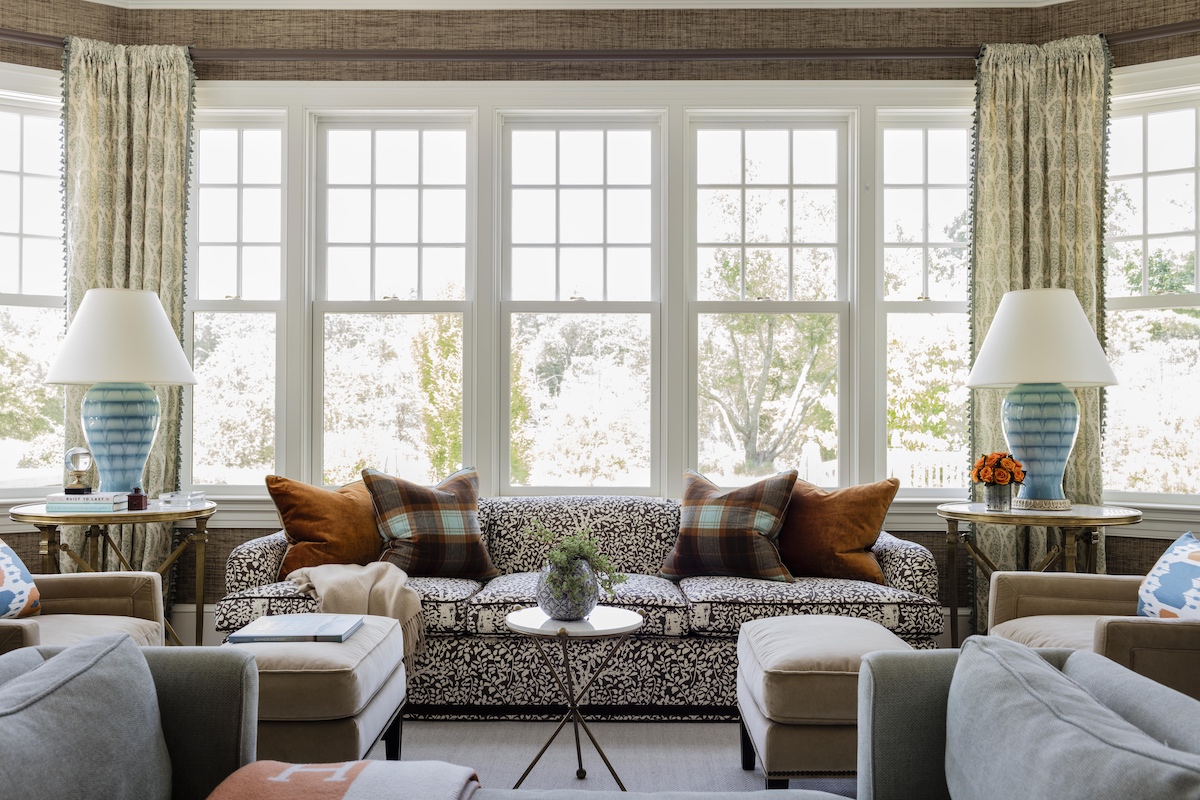
Photo by Michael J. Lee
“We wanted this sofa to sit at the windowsill so it didn’t block the view. We also loved the tree of life fabric to reference the garden outside the window,” says Gannon. This sofa has a tight back so it sits a bit more upright and more conversational with the adjacent seating.
DESIGNERS’ FAVORITE SOFA FABRICS
Velvet & Mohair
“If left to my own devices, I would use velvet (I love the nap) or mohair (it’s cozy and while pricey is practically bullet proof and will outlast you!) on every big piece of upholstery,” says Gannon. Adds Hillery, “I always have to check with the clients and make sure they are okay with the fact that velvet is going to crush. You have explain that it will wear beautifully and evolve and eventually become that yummy 10-year-old sofa that everyone has just loved on; it’s a process. It may not be the best choice for my ‘engineer’ clients where everything has to be just so!” Tollett says she just put mohair on a vintage chair and that it is a good choice for cats because it is so durable and immune to almost anything.

Photo by Kip Dawkins
Hillery created this moody, navy den for a business executive that features a plush velvet green sofa; handsome leather Stickley chair and a curated library collection for a sanctuary of style and substance.
Linen
“I do love the relaxed and textural quality of linen and how it beautifully drapes over a piece of furniture,” says Gannon. Adds Hillery, “We use a lot of stain-treated natural linen and also indoor/outdoor linen-look fabrics because for many of our clients, maintenance and cleanability are paramount. But in my opinion, there is nothing better than chunky natural linen.”
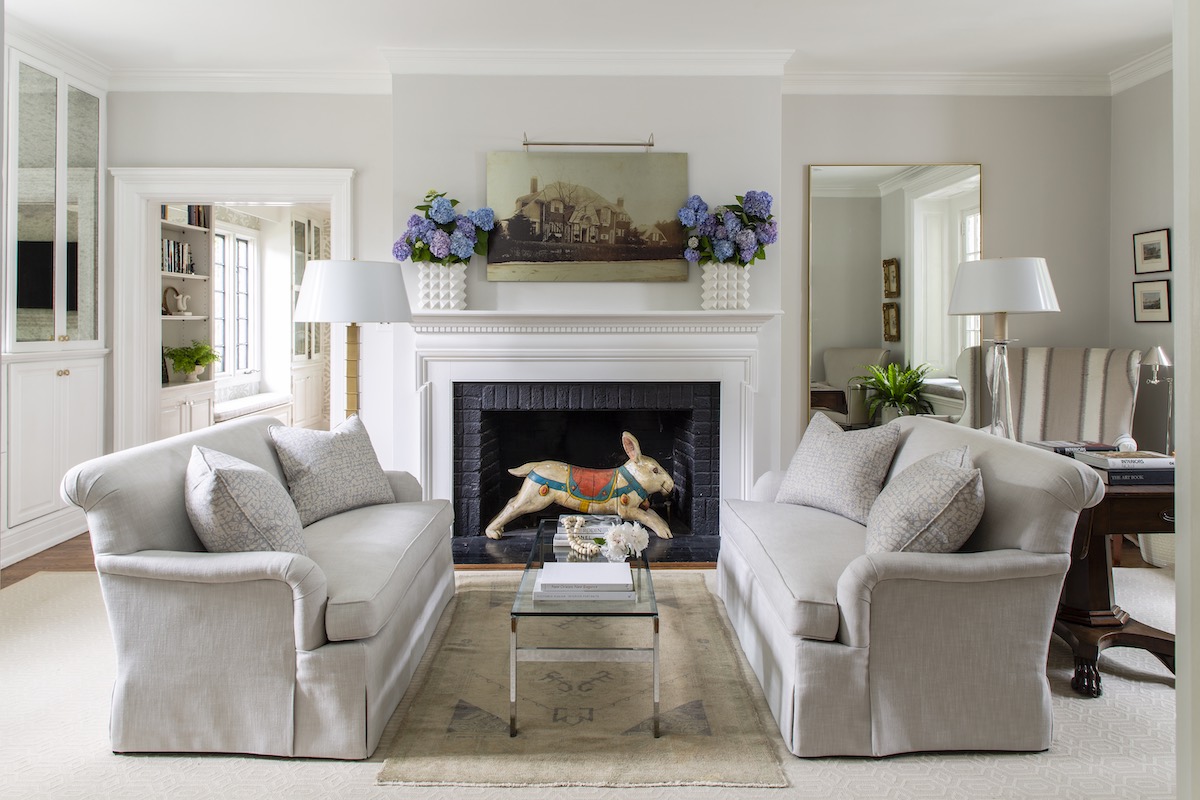
Photo by Helen Norman, courtesy of Hanover Avenue
Tollett prefers two matching sofas instead of a sectional if the room allows it. Here she include rolled arm styles with bench cushions in a neutral fabric for a calming look.
Leather
While all the designers like leather, whether it’s a classic, tufted chesterfield or other stylized modern options, there are several practical considerations, which Tollett explains: “I try to get a large sample of leather—at least a 22-inch square. I want the client to really feel and squeeze and scratch the leather so they see how it is going to break in. You don’t want it to feel too stiff or scratch too easily. You want it to wear in like a pretty handbag or a good pair of boots or even like a marble countertop. I also can’t stand leather sofas that have too many seams; that can really cheapen the piece. If you look on the side and see an extra seam, it means that they have cut the hide too many times.”

Photo by Helen Norman, courtesy of Hanover Avenue
A leather track arm sofa will never go out of style and will only get better with age. “In summer with the air conditioning blowing, a leather sofa can feel a little cold so I always include a mix of pillows in fabrics like velvet,” says Tollett.
Fabrics to Avoid
Even though almost every fabric can be stain-treated and used in upholstery, designers have a couple of caveats to keep regret at bay. “I would steer clear of any viscose or viscose blend because it does not like water or any liquids and it’s not easy to live with,” says Gannon. “ Choose a high-performance or all-natural fabric that can at least be wet spot-cleaned, especially when there are young children and pets.” Hillery adds that it’s important to avoid textures that can be easily snagged like boucle finishes.
Skirts
To skirt or not to skirt? “I like a mix in the same room for interest and variety in the space, and skirts can impart a pretty softness in the room,” says Hillery. “I also like skirts in more elegant spaces, and I really love a waterfall skirt and using button or frog closures.” Gannon has this advice: “If it’s a big room, skirting can impart a little coziness. In a smaller room, legs can add more breathing room because you can see under the sofa and there is airflow under it. It tends to have a little lighter feel.” On a practical note, Tollett advises that not every fabric is appropriate for skirting. “It has to be a fabric that can fall and hang well like linen. A chenille would turn into a tutu! Also, the length of a skirt is key; if it is too short, it will make the sofa look squatty.”
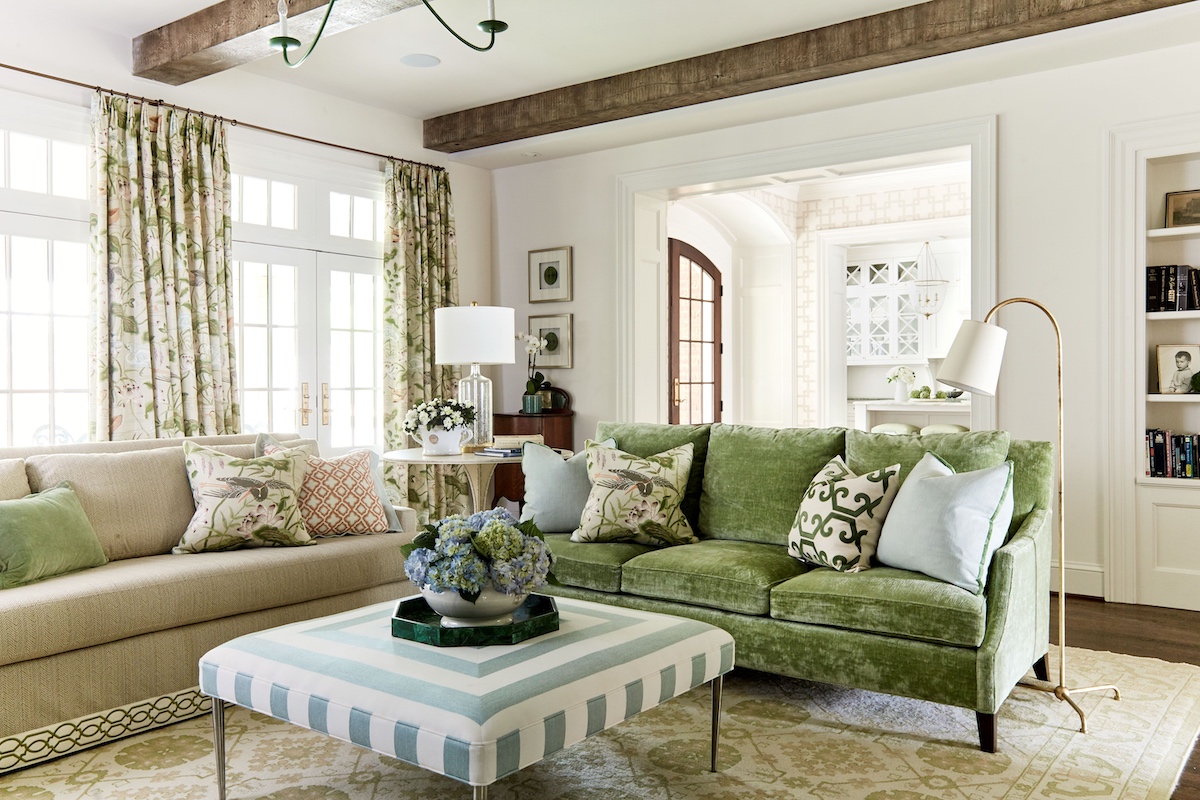
Photo by Kip Dawkins
“I wanted the living room in a new addition in Virginia to feel collected and create the illusion that different family members had passed down the furniture in this space,” says Hillery. “So even though the sofas were brand new, I upholstered them in different fabrics and textures to give them and the space instant character Wooden beams add rustic charm to the space while rich fabrics and patterns reflect the beauty of nature.”
More Finishing Details
Dressmaker details such as fringe, nailhead trim, tufting, buttons and contrasting cording add flair and reflect that someone thought about the design and it didn’t come off the shelf. “Finishing touches say this is not your average sofa and that great care went into creating this piece,” says Hillery. Adds Howard, “There are many beautiful ways to make a sofa feel custom and special, whether it’s a contrasting welt, fringe on the bottom, contrast tape on a skirt, and they are not that expensive and can truly make the piece shine.” Designers also caution that if you like a tufted style, remember that not all fabrics tuft properly; more luxurious fabrics like velvet, mohair, and leather work best.

Photo by Michael J. Lee
“We designed this sofa opposite a fabulous floor to ceiling window so the family could lounge and gaze out the window,” says Gannon. “We also wanted the texture of the biscuit tufting on the seat to mirror the rectilinear paneling on the walls. We loved the velvet (I am a fanatic) because it makes you want to just curl up and never get up!”
“Go with what you love; don’t let a salesperson or friend talk you out of what you want or fall into the trend of the day. If you buy good quality and what you love, it’s going to feel timeless.”
—Robin Gannon
By Alice Welsh Doyle
FEATURED DESIGNERS

Photo by Zach Gallitz Photography
Anne Hulcher Tollett of Hanover Avenue | @hanoveravenue | Richmond, VA
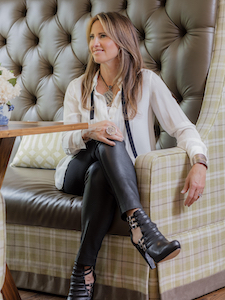
Photo courtesy of Robin Gannon
Robin Gannon of Robin Gannon Interiors | @robingannoninteriors | Lexington, MA

Photo courtesy of Phoebe Howard
Phoebe Howard of Mrs. Howard and Max & Company | @phoebehoward_decorator | Jacksonville, FL
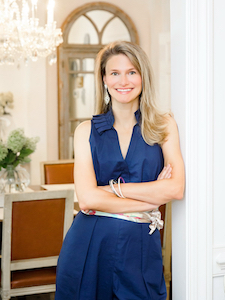
Photo courtesy of Sara Hillery
Sara Hillery of Sara Hillery Interior Design | @sarahilleryinteriordesign | Richmond, VA
MORE DESIGNER STYLE
- Coming Soon: The Designers’ Guide to Casegoods and Cabinetry
- The Designers’ Guide to Choosing Lampshades
- Choosing the Right Wallpaper for Your Space
- The Designers’ Guide to Kitchen Lighting


